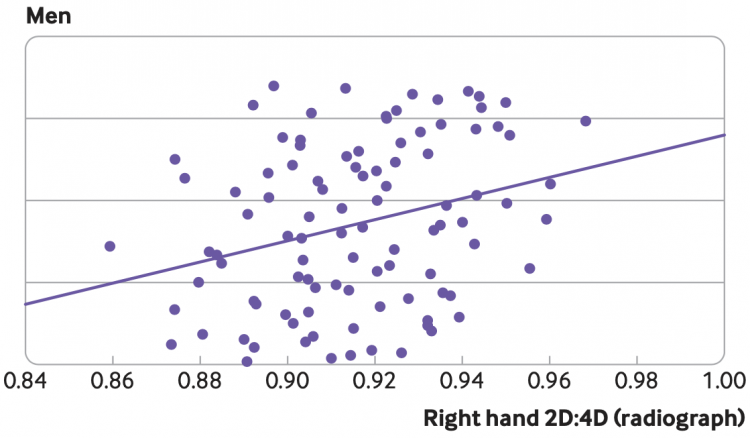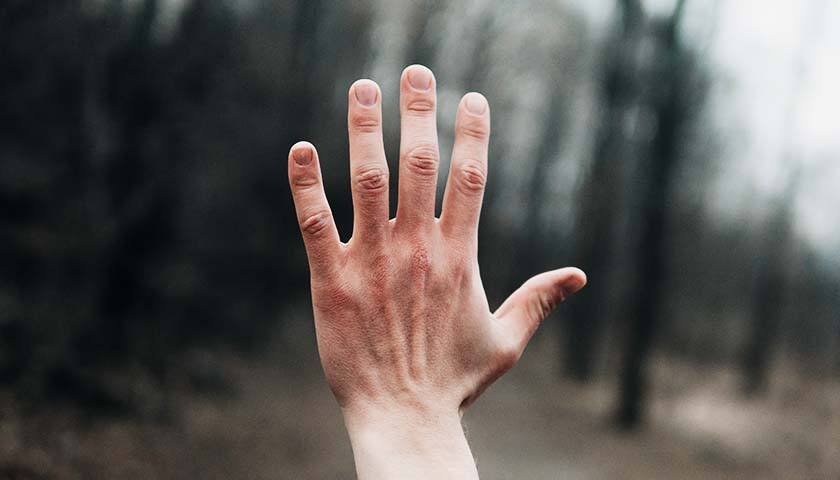by Ross Pomeroy
Take a look at one of your hands, specifically focusing on your index finger (2D) and ring finger (4D). If you’re a man, your index finger is probably slightly shorter than your ring finger. If you’re a woman, they’re probably about the same length. How these two fingers compare might not mean much to you, but some scientists think the ratio between the lengths of these two fingers (2D:4D) can predict your health, personality, musical ability, and even your sexual orientation. Why? Because these researchers think that 2D:4D is a biomarker of exposure to higher levels of testosterone in the womb, and this, they say, can have lasting effects throughout one’s life. One of them even thinks that sports teams should use the ratio as a criterion for selecting players!
Dr. James Smoliga, a Professor of Physiology in the Department of Physical Therapy at High Point University, is not one of those scientists. Reviewing some of the more than 1,400 papers published over the past two decades linking 2D:4D to pretty much anything (reduced risk for video game addiction, sumo wrestling success, artistic ability, penis size, etc.), he grew skeptical that this one physical trait could reveal so much about our lives.
Smoliga soon learned that little to no evidence in humans supports 2D:4D evangelists’ fundamental assumption, that differences in prenatal hormone levels correlate with variations in the finger ratio. So what could account for all those aforementioned peer-reviewed associations? He noticed that a lot of the studies compared 2D:4D to all sorts of variables. Some variables came back with statistically significant associations – indicating a 5% or lower chance of the link being a fluke – but many more did not. Smoliga thus hypothesized that the vast majority of published 2D:4D correlations are false positives, discovered simply due to random chance, not because of a genuine biological cause. And he conceived of a cheeky way to demonstrate his hunch…
Smoliga and four of his students carried out an experiment to find if the 2D:4D ratio might correlate with luck. Thus, they measured the finger ratios of 176 participants on both their left and right hands, then had subjects randomly pick cards out of a shuffled deck to try to form poker hands. Lo and behold, men with a lower 2D:4D ratio (meaning their index and ring fingers are close in length) on their right hands were more likely to get a better poker hand, and the result was highly statistically significant! Guys, take a look at your right hands! You might be lucky!

Sorry, no, says Smoliga.
“When interpreted in the context of the 2D:4D literature, this finding provides further evidence that 2D:4D might be a universal biomarker of one’s fate. In reality, our statistically significant results are actually spurious, and raise the possibility that other claims regarding 2D:4D’s association with human health and behavior might also be false positive findings owing to weak experimental and statistical methodology,” he wrote.
In an email with RCS, Smoliga added that publication bias likely plays a factor in the 2D:4D’s prominence.
“I suspect that the 2D:4D evangelists are selectively reporting only the positive results and the non-findings simply never get published, which makes it look like there is lots of support for the concept.”
Smoliga and his students’ skeptically-minded paper might be seen by 2D:4D believers as a tad ‘Grinchy’. Fitting, then, that it was published in Christmas edition of the British Medical Journal, which is typically reserved for quirky, yet insightful research.
Source: Smoliga J M, Fogaca L K, Siplon J S, Goldburt A A, Jakobs F. Giving science the finger—is the second-to-fourth digit ratio (2D:4D) a biomarker of good luck? A cross sectional study BMJ 2021; 375 :e067849 doi:10.1136/bmj-2021-067849
– – –
Ross Pomeroy is a contributor to RealClearScience.





